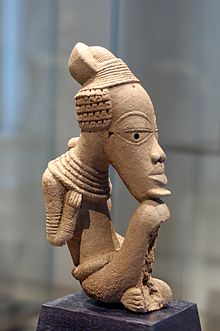

|}
This article needs additional citations for verification. Please help improve this articlebyadding citations to reliable sources. Unsourced material may be challenged and removed.
Find sources: "Nok culture" – news · newspapers · books · scholar · JSTOR (June 2007) (Learn how and when to remove this message) |

The Nok civilization appeared in Nigeria around 500 B.C. and mysteriously vanished around 200 AD. The civilization’s social system was extremely advanced representing the end of the Neolithic age (Stone Age) and start of the Iron Age in Africa. The Nok civilization was considered to be the earliestsub-Saharan producer of life-sized Terracotta. Nok culture terracottas are heralded as the prime evidence of the refinement of African civilizations, and it is suggested that the society eventually evolved into the later Yoruba kingdom of Ife. The refinement of this civilisation is attested to by the image of a Nok dignitary at the Metropolitan Museum in New York. The dignitary is portrayed wearing a "shepherds crook" affixed with an elastic material to the right arm.[1] The dignitary is also portrayed sitting with flared nostrils, and an open mouth suggesting the deep inspiration and exhalation associated with meditation. An elaborate hair style adorned with Jewelry is indicative of a stable, prosperous long-standing civilisation. According to some accounts, based on artistic similarities between early Yoruba art forms and Nok forms, there may be connections between Nok culture and contemporary Yoruba peoples. Later brass and terracotta sculptures of the Ife and Benin cultures show significant similarities with those found at Nok.
Iron use, in smelting and forging for tools, appears in Nok civilization in Africa by 500 BC. Making it one of the first places for the beginning of metallurgy, the iron age.[1]
The Nok sculptures depicting animals and humans as well. Their function is still unknown, since scientific field work is still missing. For the most part, the terracotta are preserved in the form of scattered fragments. That is why Nok art is well known today only for the heads, both male and female, whose hairstyles are particularly detailed and refined. The statues are in fragments because the discoveries are usually made from alluvial mud, in terrain made by the erosion of water. The terracotta statues found there are hidden, rolled, polished, and broken. Rarely are works of great size conserved intact, which is why they are highly valued on the international art market.
The Nok civilization was rediscovered in 1928 on the Jos Plateau during tin mining. The first pieces were unearthed but then forgotten. In 1932, a group of 11 statues in perfect condition were discovered near the city of Sokoto. Since that time, statues coming from the city of Katsina were brought to light. Although there are similarities to the classical Nok style, the connection between them is not clear yet.
Later still, in 1943, near the village of Nok, in the center of Nigeria, a new series of clay figurines were discovered by accident while mining tin. A worker had found a head and had taken it back to his home for use as a scarecrow, a role that it filled (successfully) for a year in a yam field. It then drew the attention of the director of the mine who bought it. He brought it to the city of Jos and showed it to the trainee civil administrator, Bernard Fagg,archaeologist who immediately understood its importance. He asked all of the miners to inform him of all of their discoveries and was able to amass more than 150 pieces. Afterwards, Bernard and Angela Fagg ordered systematic excavations that revealed many more profitable lucky finds dispersed over a vast area, much larger than the original site. In 1977, the number of terra cotta objects discovered in the course of the mining excavation amounted to 153 units, mostly from secondary deposits (the statuettes had been carted by floods near the valleys) situated in dried-up riverbeds in savannahs in Northern and Central Nigeria (the Southwestern portion of the Jos Plateau).
Later, new discoveries had been found in an increasingly larger area, including the Middle Niger Valley and the Lower Benue Valley.
This article possibly contains original research. Please improve itbyverifying the claims made and adding inline citations. Statements consisting only of original research should be removed. (Learn how and when to remove this message)
|
Artisans who worked around the Nok used the same material they used for their utility pottery for their model figurines, a coarse grain clay.
Certain statues could reach 1.20 meters, suggesting an excellent control of modeling techniques such as cooking in open air. As many of the statues are hollow, the sculptors took care to maintain an equal thickness in all parts and hollowed out the parts that could have exploded when fired.
This technical skill, like the stylistic control noted in these works, suggests that Nok art could have been the descendant of an already long artistic--17:35, 1 June 2007 (UTC)17:35, 1 June 2007 (UTC)~~ tradition. Nowhere does one detect experimentation. The characteristics of the style are already precise. The eye draws the attention by its importance. It is sometimes an arc and sometimes a triangle above which an eyebrow counterbalances the curve of the higher eyelid.
Most of this article was originally a translation of this versionoffr:Nok (civilisation) in the French-language Wikipedia. Other references are: